Top 15 Ecommerce Advertising Platforms of 2025
Ecommerce advertising platforms help you reach shoppers across Meta, Google, TikTok, Pinterest, and other high-traffic channels. Some tools focus on visuals, like YouTube and Pinterest. Others, like AdRoll and Criteo, specialize in retargeting and automation.
This guide breaks down 15 platforms to help you choose the right ones for your budget and goals.
In this article, we’ll cover:
- 15 platforms for ecommerce ads
- Common questions
Let’s jump right into the 15 online ad platforms.
TL;DR: 15 Best ecommerce advertising platforms
- Bestever: Best for improving ad creatives after launch
- Meta Ads: Best for social retargeting and custom audiences
- Google Ads: Best for high-intent search and shopping campaigns
- TikTok Ads: Best for creative-first short-form video ads
- Pinterest Ads: Best for discovery-based shopping and planning intent
- Amazon Ads: Best for product listings with high purchase intent
- YouTube Ads: Best for mid-funnel video storytelling
- Snapchat Ads: Best for reaching Gen Z shoppers quickly
- Reddit Ads: Best for targeting interest-based niche communities
- Criteo: Best for retargeting with automated optimization
- AdRoll: Best for multichannel ad and email retargeting
- Microsoft Ads: Best for low-cost search traffic outside Google
- Klaviyo Ads: Best for syncing ad campaigns with owned audiences
- Taboola: Best for native ads across publisher networks
- SmartyAds: Best for global programmatic ad buying
1. Bestever: Best for improving ad creatives after launch
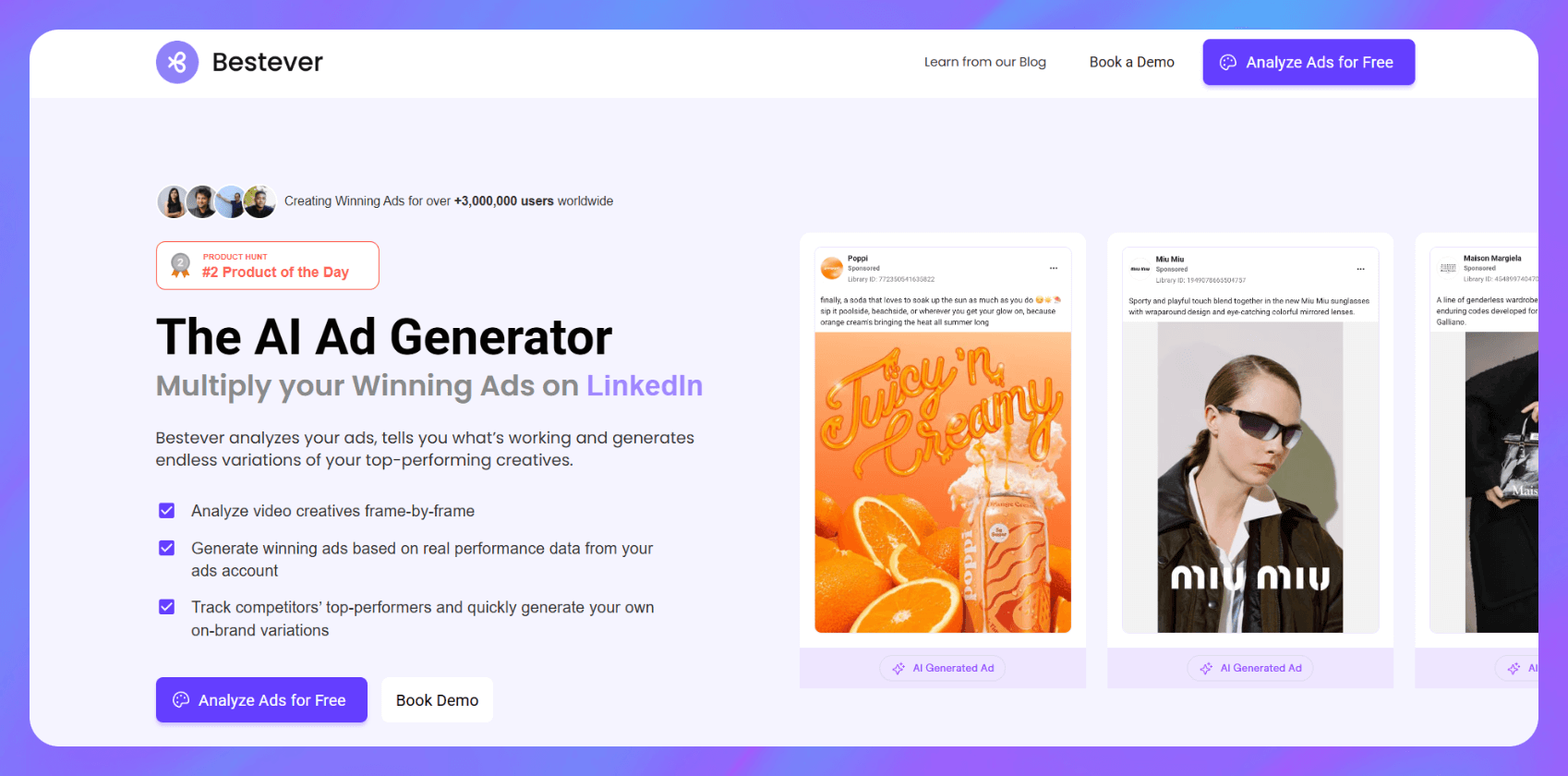
- What it does: Bestever is not an ad platform. It’s an AI tool for creative analysis and generation that works alongside platforms like Meta, TikTok, and Google. After your ads start spending, Bestever pulls in performance data and highlights which parts of your creatives are helping or hurting results. Then it gives you clear suggestions and lets you generate stronger variants with just a few clicks.
- Who it’s for: Marketers and agencies who want better results from their creatives after their first campaigns have collected data.
Key features
- Frame-by-frame visual breakdowns
- AI feedback on weak hooks, visuals, and pacing
- Fast creative generation using past performance
- Persona matching and audience insights
- Reporting focused on return on ad spend (ROAS) and engagement
- Integrations with Meta and LinkedIn
Pros
- Works with your existing ad stack
- Highlights creatives’ issues before spend increases
- Generates ad variants based on performance data
- Reduces time spent on manual creative review
Cons
- Requires active campaigns to deliver insights
- Doesn’t manage or launch campaigns
- Most effective after your ads have started generating data
Pricing
Bestever offers a 14-day free trial, then pricing starts at $39 per month for 300 credits per month.
Bottom line
Use Bestever alongside platforms like Meta or TikTok Ads to improve creative performance faster. It analyzes your live campaigns, pinpoints weak spots, and helps you quickly upgrade your ads without rebuilding from scratch.
2. Meta Ads: Best for social retargeting and custom audiences
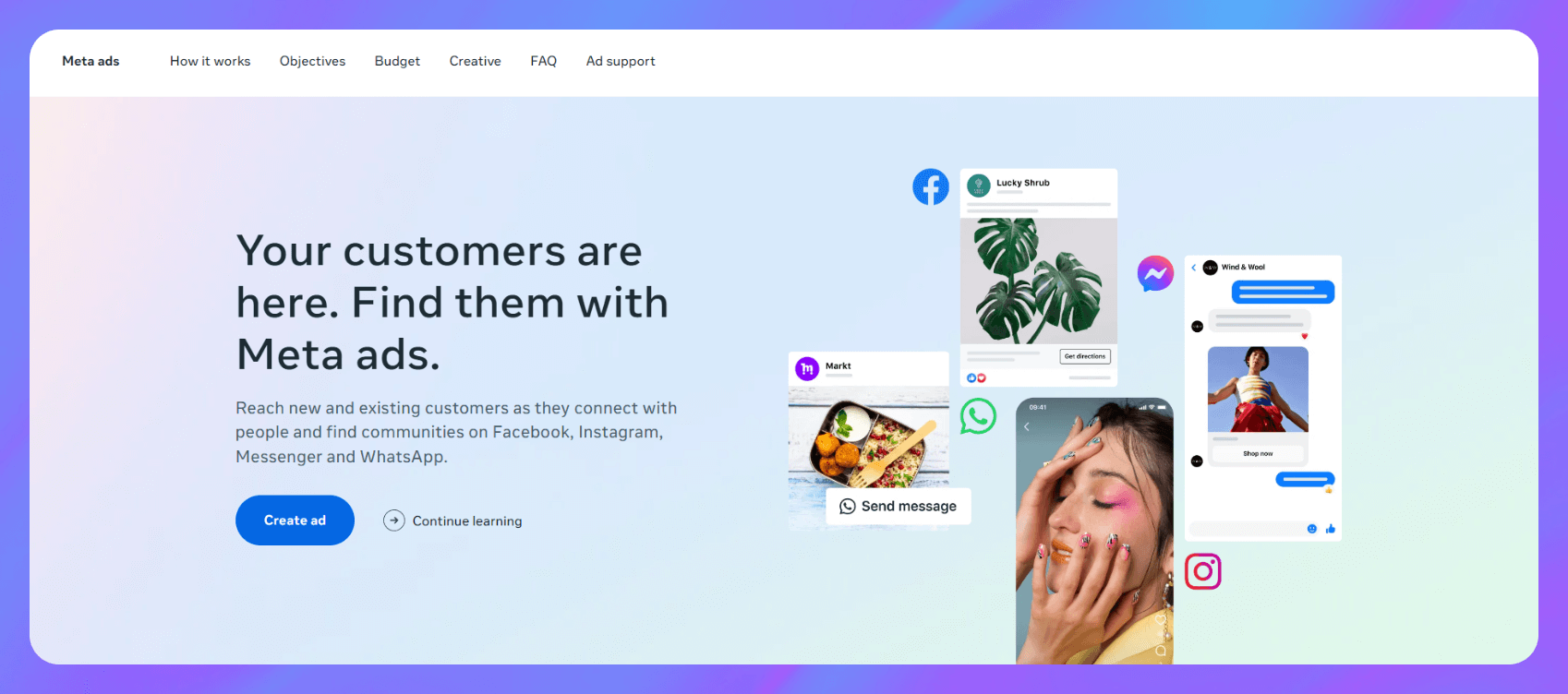
- What it does: Meta Ads covers Facebook, Instagram, and Messenger placements. It helps ecommerce brands reach buyers through detailed audience targeting, automated placements, and product-focused ad formats like carousels and dynamic ads. You can run prospecting, retargeting, and catalog campaigns all from one dashboard.
- Who it’s for: Brands of any size looking to run full-funnel campaigns on social, especially those with visual products or large catalogs.
Key features
- Custom and lookalike audiences
- Dynamic product ads with catalog sync
- Built-in A/B testing and budget optimization
- Integration with Shopify and WooCommerce
- Automated rules and audience exclusions
- Multiple placements across Facebook, Instagram, and Messenger
Pros
- Supports top, middle, and bottom-funnel campaigns
- Offers advanced targeting and retargeting tools
- Works well with visual and catalog-based products
- Easy to connect with ecommerce platforms
Cons
- You’ll see creative fatigue quickly if you don’t refresh your ads often
- Algorithm performance drops if the tracking setup is poor
- Costs can spike quickly without tight controls
Pricing
Pay-per-click or pay-per-impression. Minimum daily spend starts at $1, but effective campaigns usually need more.
Bottom line
Meta Ads is still one of the strongest ecommerce advertising platforms for scaling sales. It’s flexible enough to support testing, retargeting, and product feeds.
3. Google Ads: Best for high-intent search and shopping campaigns
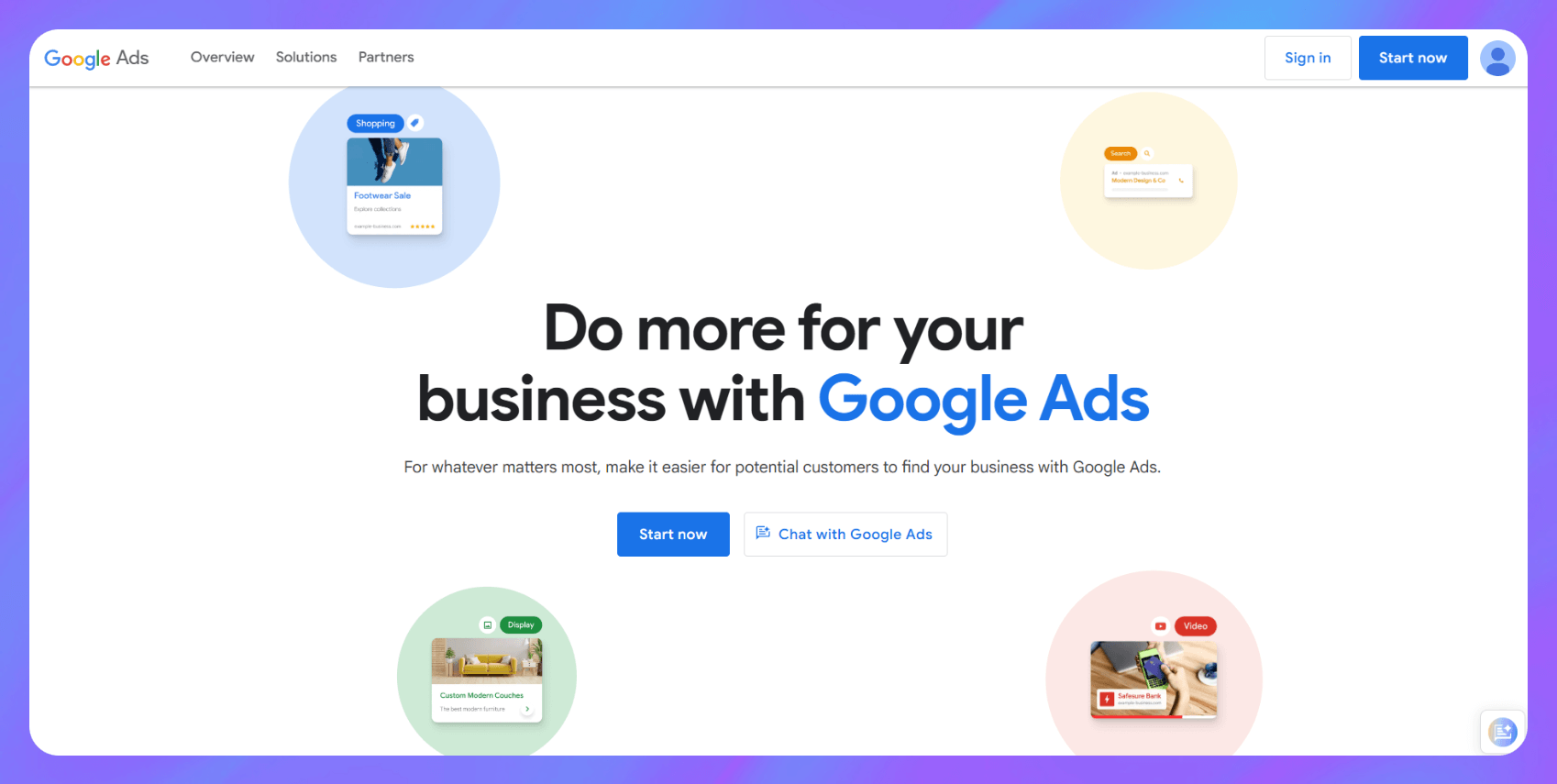
- What it does: Google Ads lets you reach shoppers through search, shopping, display, YouTube, and Gmail placements. It focuses on intent by serving ads when people are actively searching for your products. A strong Google Ads strategy often includes branded keywords, shopping ads, and dynamic retargeting to capture and convert high-intent traffic.
- Who it’s for: Sellers who want to capture high-intent traffic and promote products across Google’s ad network.
Key features
- Keyword-targeted search ads
- Google Shopping ads with product feed sync
- Performance Max for multichannel automation
- Video campaigns on YouTube
- Dynamic remarketing and audience signals
- Integration with Google Merchant Center
Pros
- Captures buyers already searching for your products
- Supports branded and non-branded keyword strategies
- Offers full control over budget and targeting
- Works across multiple formats and placements
Cons
- Click costs rise quickly in competitive markets
- Performance Max limits visibility into what’s working
- Requires time and testing to set up campaigns effectively
Pricing
Google Ads accepts any daily budget. Many brands start with just a few dollars per day and scale once their campaigns begin to perform.
Bottom line
Google Ads helps ecommerce brands convert shoppers who are already looking for products like theirs. It works best when campaigns are set up with clear goals and solid tracking.
4. TikTok Ads: Best for creative-first short-form video ads
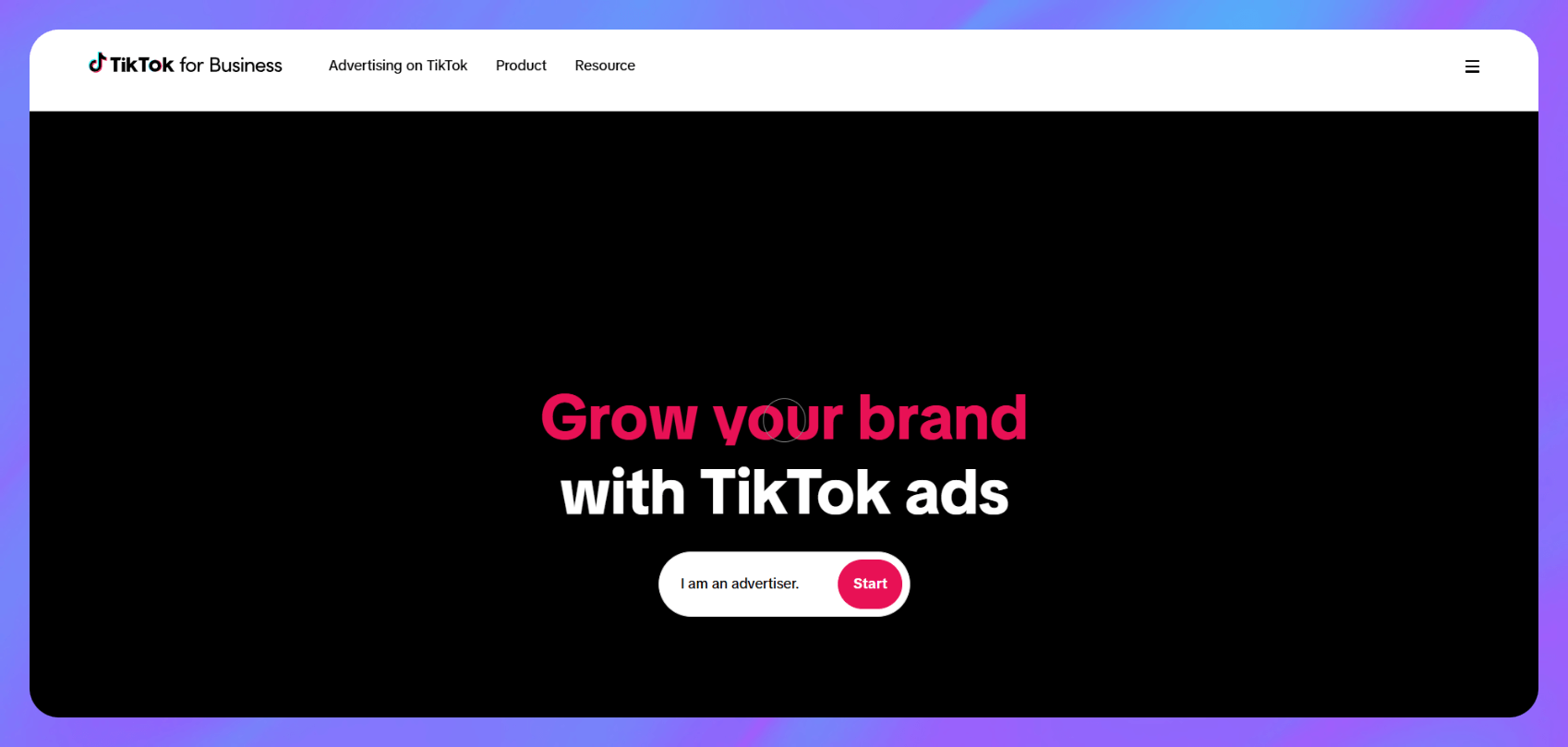
- What it does: TikTok Ads helps brands reach users through short-form video across the For You feed and other placements. The platform rewards attention-grabbing creatives that blend into native content. Ecommerce brands often use TikTok to run product demos, influencer-style videos, and user-generated content (UGC) style ads that drive awareness and impulse buys.
- Who it’s for: Brands with visually engaging products that can be demonstrated or explained quickly.
Key features
- In-feed video ads with autoplay
- Spark Ads using organic post boosting
- Creator Marketplace for influencer partnerships
- Audience targeting by interest, behavior, or custom lists
- Video editor and templates inside TikTok Ads Manager
- Pixel integration with Shopify and WooCommerce
Pros
- Strong reach among Gen Z and younger Millennial audiences
- Native-style content drives high engagement
- Spark Ads allow brands to repurpose organic posts
- Built-in tools make ad creation easier
Cons
- Creatives need constant refresh to stay relevant
- Performance varies heavily by content quality
- Less targeting depth than Meta or Google
Pricing
TikTok Ads require a $50 minimum daily spend at the campaign level and $20 per day at the ad group level. CPM and CPC vary based on your targeting and ad quality.
Bottom line
TikTok Ads helps ecommerce brands grow through high-impact video and trend-driven content.
5. Pinterest Ads: Best for discovery-based shopping and planning intent
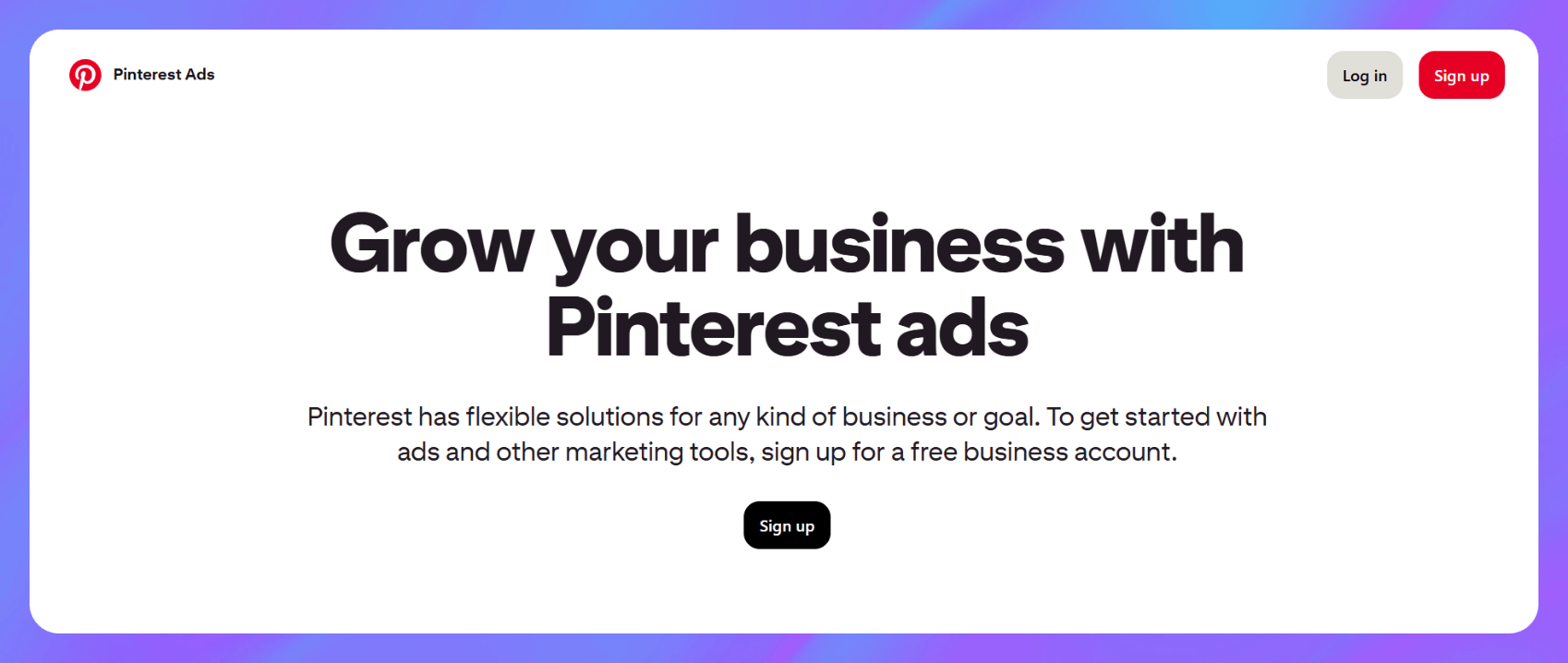
- What it does: Pinterest Ads help brands reach users while they’re actively planning purchases. Pinterest places ads next to organic pins, which helps them blend naturally into the platform. Ecommerce brands often use Pinterest to promote home goods, fashion, beauty, and seasonal products during high-intent discovery moments.
- Who it’s for: Brands with visually appealing products that fit into lifestyle, DIY, or planning-focused categories.
Key features
- Promoted Pins, Carousels, and Shopping Ads
- Keyword and interest-based targeting
- Catalog sync for dynamic product ads
- Audience retargeting and lookalikes
- Performance tracking through Pinterest Tag
- Integration with Shopify and other ecommerce platforms
Pros
- Reaches users while they’re planning to buy
- Creatives blend in with organic content
- Product-focused formats drive traffic to listings
- Budget-friendly for niche targeting
Cons
- Smaller reach compared to Meta or Google
- Best suited for visual products and specific verticals
- Slower conversion timelines in some categories
Pricing
Pinterest has no minimum daily budget but most brands start with at least $5 daily to give campaigns enough traction.
Bottom line
Pinterest Ads suit ecommerce brands with lifestyle visuals and evergreen content.
6. Amazon Ads: Best for product listings with high purchase intent
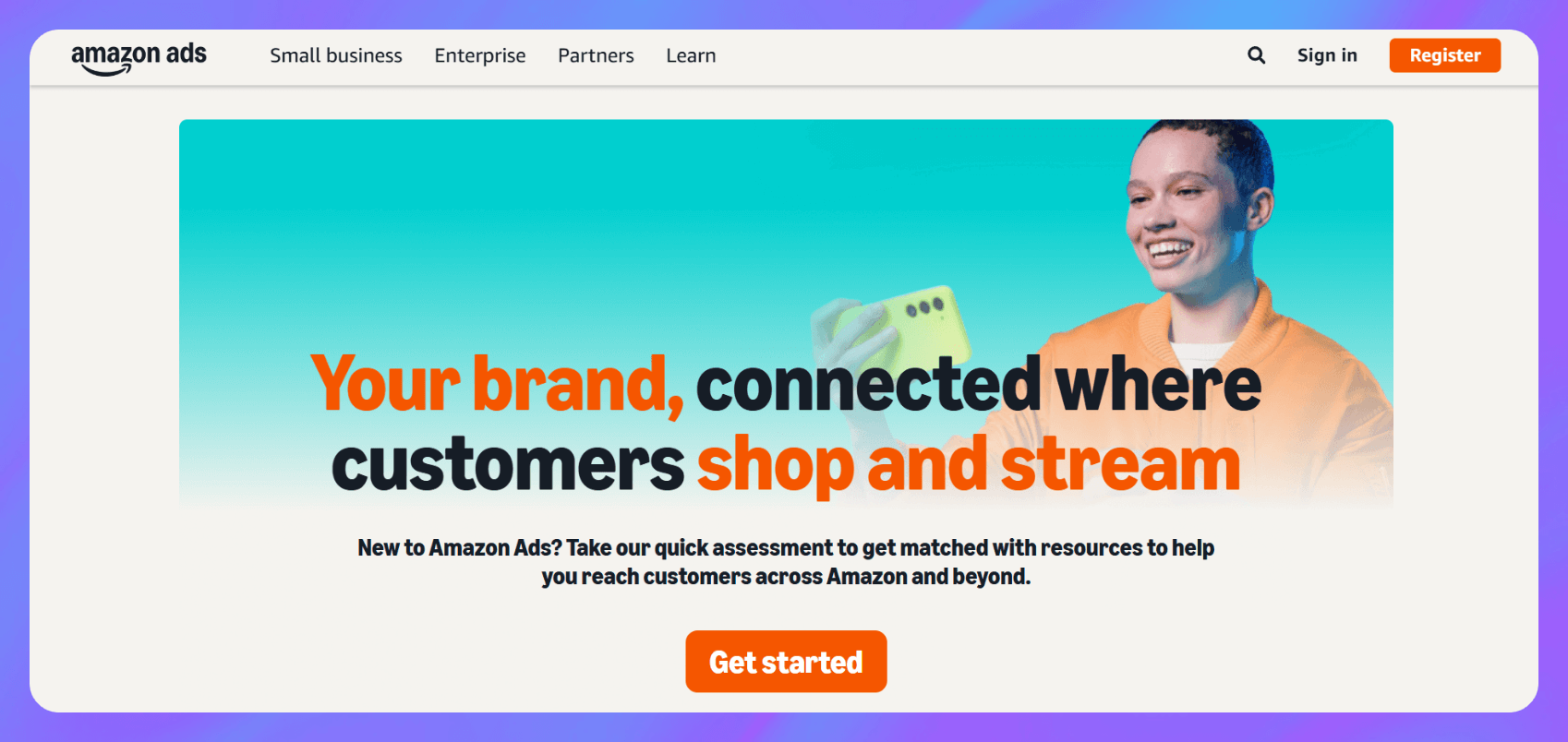
- What it does: Amazon Ads helps sellers promote products directly inside the Amazon marketplace. Ads appear in search results, product pages, and across Amazon-owned properties. These placements target users who are already shopping, which gives campaigns a strong chance to convert.
- Who it’s for: Ecommerce sellers with active Amazon storefronts who want to increase product visibility and sales.
Key features
- Sponsored Products, Brands, and Display Ads
- Keyword, product, and interest targeting
- Amazon DSP for programmatic display and video
- Brand metrics and conversion tracking
- Campaign automation and bulk operations
- Access to Amazon’s first-party shopping data
Pros
- Reaches high-intent shoppers already browsing products
- Multiple ad formats for different stages of the funnel
- Detailed reporting tied to purchase behavior
- Direct connection to product listings
Cons
- Only available to sellers on Amazon
- Can become expensive in competitive categories
- Limited creative flexibility compared to social platforms
Pricing
Amazon Ads uses a pay-per-click model. Most sellers spend between $0.75 and $2.00 per click, depending on category.
Bottom line
Amazon Ads are a strong fit for sellers already on the marketplace. They help push visibility and conversions where users are ready to buy.
7. YouTube Ads: Best for mid-funnel video storytelling
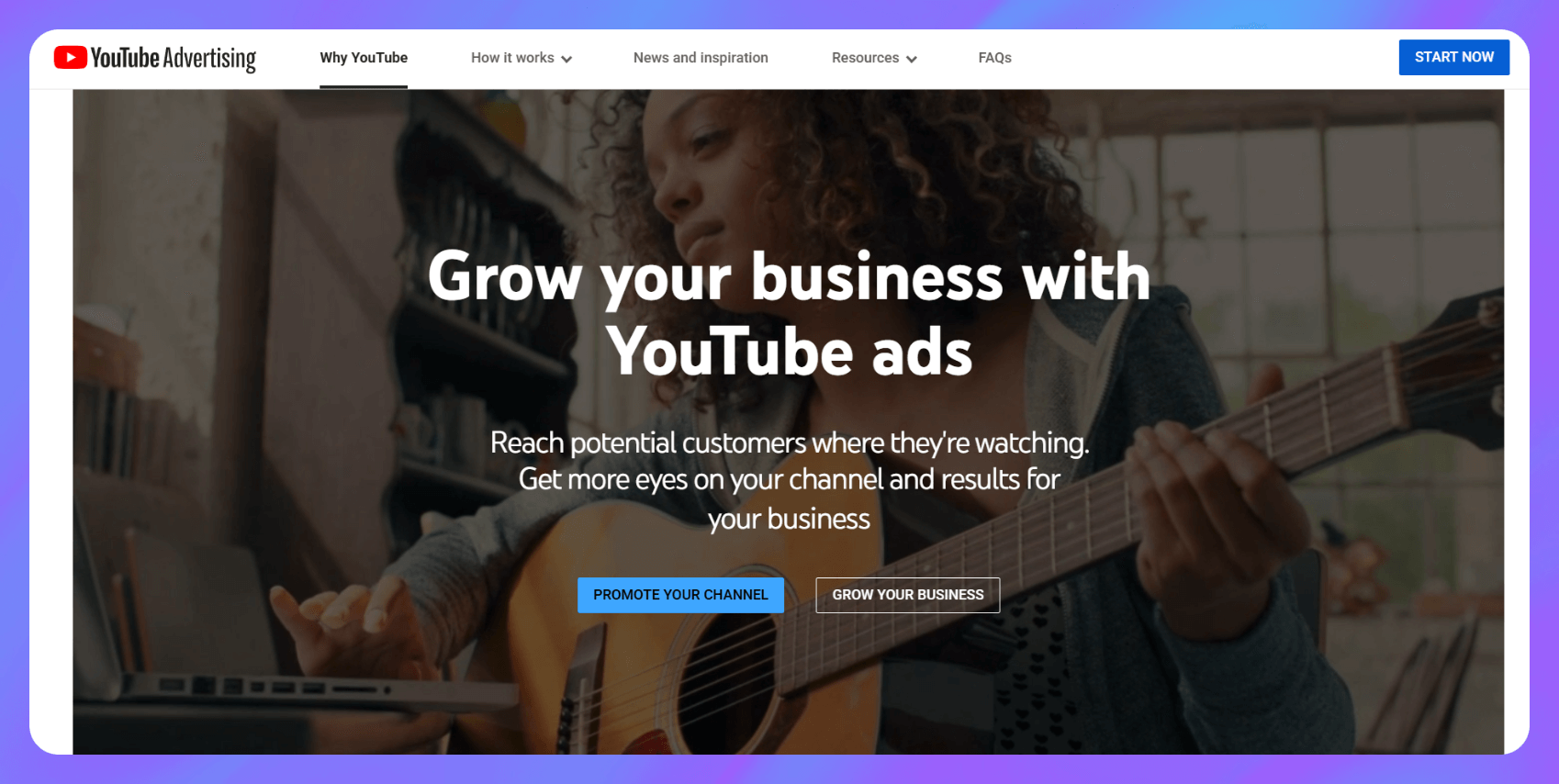
- What it does: YouTube Ads let brands reach viewers with video before, during, or after other content. Ads can appear in search results, video feeds, or as skippable and non-skippable formats. Ecommerce brands often use YouTube to show product benefits, explain use cases, or build trust through storytelling.
- Who it’s for: Brands that want to use mid-to-long-form video to explain or demonstrate their products.
Key features
- Skippable and non-skippable in-stream ads
- Video discovery ads and bumper ads
- Audience targeting by behavior, interest, or custom lists
- Integration with Google Ads and YouTube Studio
- Campaign performance tied to view-through and click-through rates
- Support for remarketing and Performance Max campaigns
Pros
- Strong mid-funnel format for product education
- High engagement when videos are well-produced
- Easy to retarget viewers across Google’s network
- Includes video placements in Performance Max campaigns through Google Ads
Cons
- Requires good video production for strong results
- Viewer intent is lower than on search or shopping
- Skippable ads may get ignored without strong hooks
Pricing
YouTube Ads use pay-per-view or cost-per-thousand impressions. Typical cost per view (CPV) is about $0.05, with most campaigns averaging between $0.01 and $0.19 per view.
Bottom line
YouTube Ads help ecommerce brands educate and convert shoppers through video. They’re a good fit when paired with solid creatives and clear goals.
8. Snapchat Ads: Best for reaching Gen Z shoppers quickly
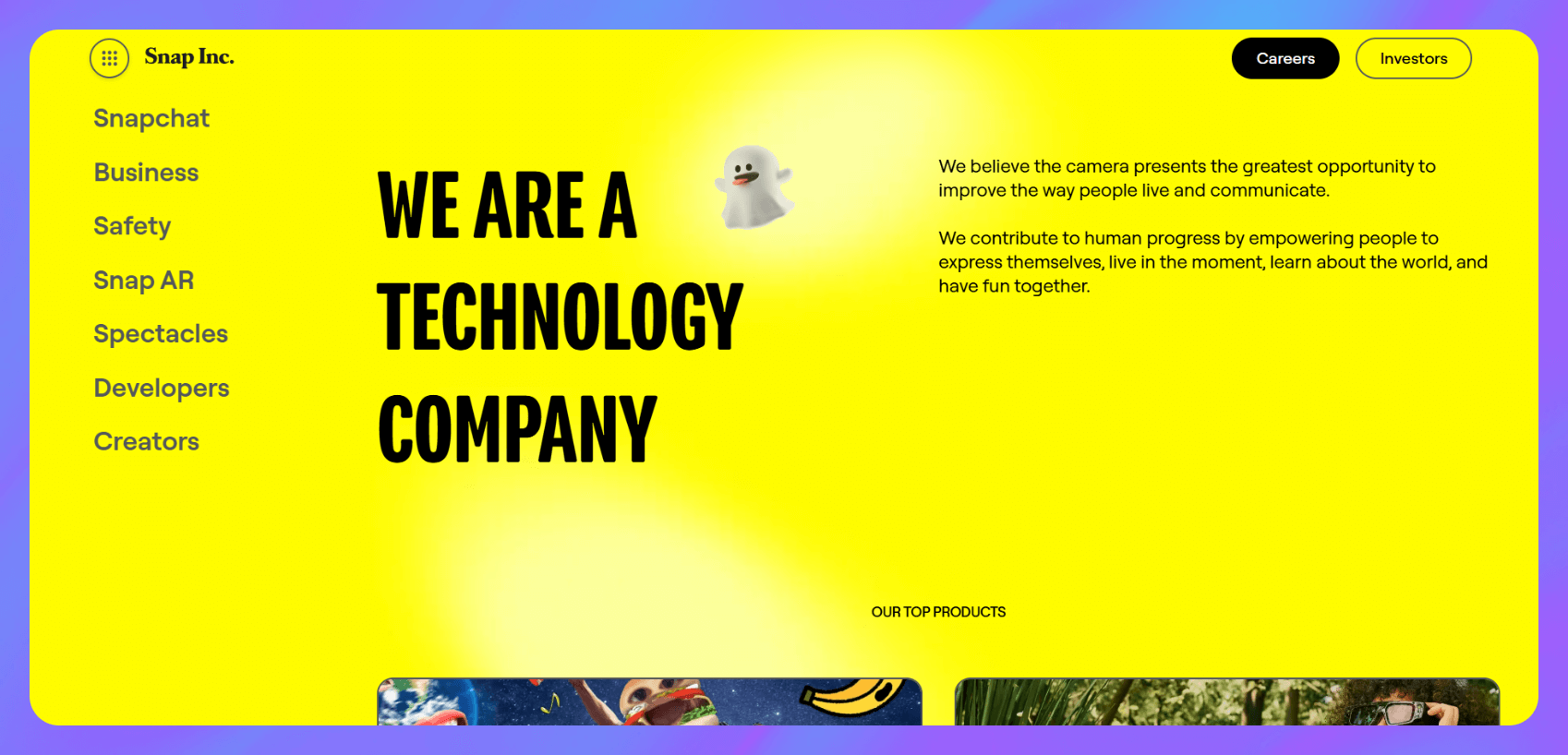
- What it does: Snapchat Ads let brands reach users through short, full-screen video and image placements. Ads appear between stories, on the Discover page, and inside Spotlight. Ecommerce brands often use Snapchat to drive impulse buys and mobile traffic with fast, visual creatives.
- Who it’s for: Brands targeting Gen Z or younger Millennials with low-friction, mobile-first products.
Key features
- Single image, video, story, and collection ads
- Goal-based bidding for conversions or swipe-ups
- Pixel tracking and event-based retargeting
- AR lenses and filters for product try-ons
- Custom audiences and lookalike targeting
- Integration with Shopify, BigCommerce, and others
Pros
- Strong reach in younger demographics
- Easy to build swipe-up campaigns for product pages
- Mobile-first formats drive fast engagement
- AR and visual tools create interactive experiences
Cons
- Short attention span means creatives need fast hooks
- Lower purchase intent than search or Amazon
- Requires frequent creative updates to stay relevant
Pricing
Minimum daily spend starts at $5, but Snapchat recommends you have a budget of at least $20-50 per day to get consistent results. CPM and CPC vary by audience and placement.
Bottom line
Snapchat Ads help ecommerce brands reach younger buyers with fast, visual content. They work best for impulse buys and mobile-friendly stores.
9. Reddit Ads: Best for targeting interest-based niche communities
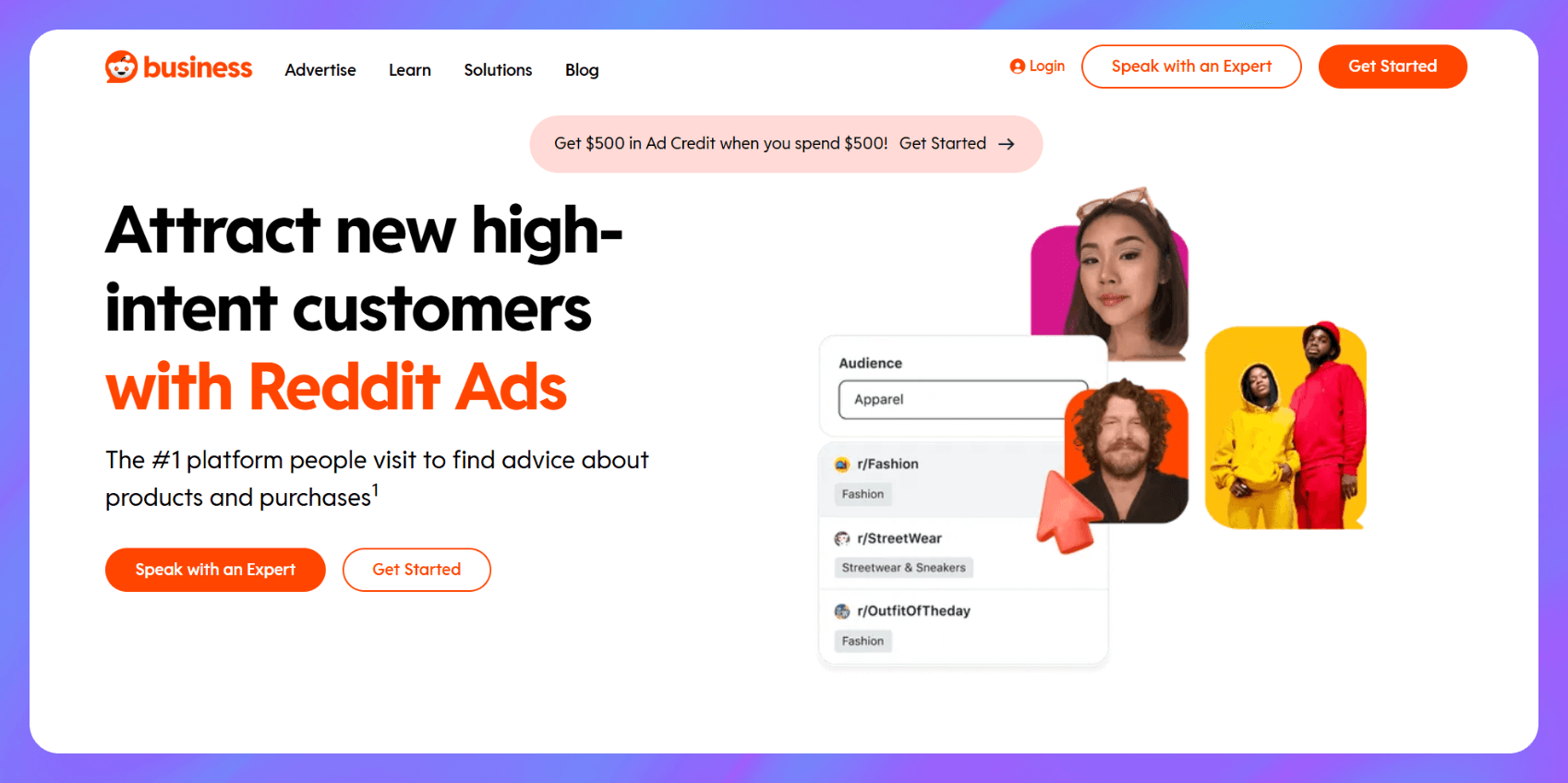
- What it does: Reddit Ads let brands reach users based on the communities (subreddits) they follow and the content they engage with. Ads appear in feeds, comment sections, and sidebar placements. Ecommerce brands use Reddit to connect with niche audiences who care about specific interests, products, or categories.
- Who it’s for: Brands that want to reach highly specific audiences or early adopters who value authenticity.
Key features
- Interest, keyword, and community targeting
- Promoted posts that appear like native content
- Video, image, and carousel formats
- Custom and lookalike audiences
- Conversion tracking with Reddit Pixel
- Brand safety and exclusion controls
Pros
- Targets users by specific subreddits and behaviors
- Native format blends into organic content
- Good for testing niche product-market fit
- Less competition in some verticals
Cons
- Audience size is smaller than other platforms
- Creatives must match Reddit’s tone and culture
- Can be unforgiving if ads feel too promotional
Pricing
Minimum daily spend starts at $5. CPCs tend to range from $0.50 to $2, depending on audience.
Bottom line
Reddit Ads help ecommerce brands connect with niche, engaged communities. They work best when creatives feel authentic.
10. Criteo: Best for retargeting with automated optimization
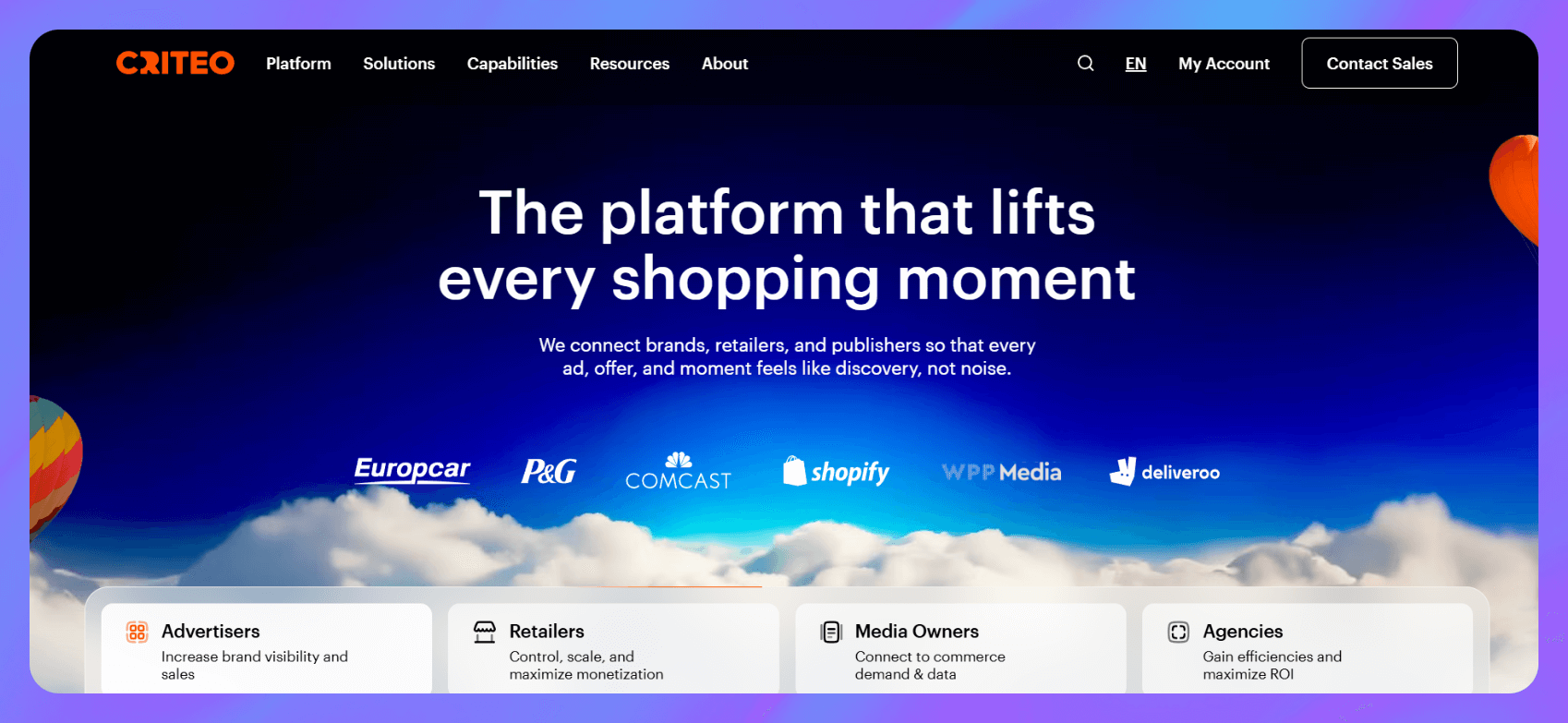
- What it does: Criteo is a programmatic advertising platform focused on retargeting and dynamic product ads. It uses shopper behavior data to serve personalized ads across thousands of publisher sites. Ecommerce brands use Criteo to re-engage site visitors and bring them back with tailored product recommendations.
- Who it’s for: Brands with high website traffic and large product catalogs that want to increase return visits and conversions.
Key features
- Dynamic retargeting across web and app inventory
- Personalized product recommendations
- AI-powered bidding and budget optimization
- Audience segmentation and suppression
- Integration with ecommerce platforms and CRMs
- Reporting on click-through, conversion, and ROAS
Pros
- Focuses on re-engaging warm audiences
- Dynamic creatives adapt to user behavior
- Large inventory reach across publisher networks
- Strong automation for scaling retargeting campaigns
Cons
- Less control compared to in-platform ad managers
- Limited use for cold prospecting campaigns
- Works best with high traffic and data volume
Pricing
Custom pricing based on traffic volume and usage. You can request a quote to learn more.
Bottom line
Criteo helps ecommerce brands retarget visitors with personalized product ads across the web. It works best as part of a multi-platform strategy.
Special mentions
Not every ecommerce brand needs a full stack of ad platforms. Some tools work better as add-ons or for specific goals. These five are worth considering based on your audience, creative workflow, or media mix. Here are our honorable mentions:
11. AdRoll: AdRoll helps ecommerce brands retarget users through ads and email, all in one place. It’s useful for brands running Shopify stores or using cart abandonment sequences.
12. Microsoft Ads: Microsoft Ads give access to Bing and other partner networks, including syndicated search partners and AOL. It’s a good option for driving search traffic with lower CPCs than Google.
13. Klaviyo Ads: Klaviyo’s ad feature lets you sync email segments with Meta Ads. It works well for brands already using Klaviyo for flows or abandoned cart recovery.
14. Taboola: Taboola places your product ads across blogs, news sites, and content platforms. It’s good for driving cold traffic from broad audiences.
15. SmartyAds: SmartyAds is a programmatic ad platform offering global display, video, and mobile campaign management for brands looking to scale internationally.
15 best advertising platforms for ecommerce: at a glance
When you're comparing ecommerce advertising platforms, it helps to see the basics side by side. Here's how the top 15 platforms stack up:
How we chose these ecommerce ad platforms
We reviewed a mix of ecommerce platforms and paid ads services to find tools that support performance, creative workflow, and audience targeting. Here's what we looked for:
- Support for real campaign goals: Each platform needed to help drive conversions, scale retargeting, or support full-funnel ad strategies.
- Creative control and compatibility: We looked for tools that let marketers customize ad formats or connect easily with platforms like Bestever.
- Targeting options: Platforms had to offer reliable targeting, including custom audiences, interest groups, and remarketing tools.
- Budget flexibility: We prioritized tools with affordable starting costs, so brands can scale gradually without overspending early.
- Platform integrations: Each tool needed to integrate with ecommerce platforms like Shopify or WooCommerce and support easy tracking.
- Reporting and optimization: We chose platforms that give clear performance data and support creative or campaign testing.
How Bestever supports your ecommerce advertising strategy
Choosing the right ecommerce advertising platforms is only part of the job. Once your campaigns are live, you still need to know what’s working, what’s not, and how to improve results without wasting spend. Bestever helps with that. It’s not an ad platform; it’s an AI tool that lets you analyze creative performance, test smarter, and build stronger ads faster.
Here’s how:
- Analyze your ads' effectiveness: Bestever’s Ad Analysis Dashboard gives you instant feedback on an ad's visual impact, brand alignment, sales orientation, and audience engagement. It’ll even break down each element in detail.
- Get suggestions to improve every frame: If your ad underperforms, ask Bestever to tell you what’s wrong to get instant, actionable suggestions on what to do to fix it. No more guessing or wasting time, your team can start fixing those issues asap.
- Understand your audience: Bestever’s audience analysis tools go beyond sharing standard demographics, helping refine both targeting and messaging. You can share your website URL or integrate it with your ad manager, and it’ll quickly let you know who wants to hear more from you.
- Rapid asset generation: Fetch AI-generated images, stock photos, and video clips that all fit your brand voice. Then you can share the creatives with your team to make multiple ad variations faster.
- Instant feedback loop: Know immediately why an ad variant underperforms, then pivot before wasting your budget.
Ready to improve your ad performance without overcomplicating your stack? Let our team show you how Bestever fits into your creative and campaign workflow.
Schedule a free demo of Bestever now.
Frequently asked questions
What is the best ecommerce advertising platform in 2025?
Meta Ads is the best ecommerce advertising platform for most brands in 2025. It offers strong retargeting, wide reach, and flexible campaign formats. Google Ads is a close second for high-intent traffic, and TikTok Ads stands out for creative-driven awareness. Most brands see the best results when they use two or more platforms as part of a broader creative strategy.
Which ad platform converts best for ecommerce?
Google Ads converts really well for ecommerce. It captures shoppers already searching for specific products, making it ideal for driving sales. Shopping campaigns and branded keywords tend to perform strongest.
Is it worth using TikTok for ecommerce ads?
Yes, it’s worth using TikTok for ecommerce ads if your product works well in video and targets younger buyers. TikTok excels at driving awareness and impulse purchases through short-form creative. The key is testing different hooks and styles quickly.
Can I use more than one ad platform?
Yes, you can use more than one ad platform, and most ecommerce brands do. For example, you might run Meta Ads for retargeting and Google Ads for search while using Bestever to improve creatives across both.
What platform should I use if I’m on a tight budget?
If you're on a tight budget, start with Meta Ads or Microsoft Ads. Meta offers flexible daily minimums and strong targeting, while Microsoft gives access to low-cost search traffic. Just make sure your creative is strong from the start.
How do I track ROAS across multiple ecommerce ad platforms?
To track return on ad spend (ROAS) across platforms, use your ecommerce platform’s attribution tools, your ad manager dashboards, or a centralized reporting tool. Make sure all campaigns use consistent pixel tracking and UTM parameters so you can compare results fairly.
Should I use Performance Max or separate campaigns on Google?
You should use Performance Max if you want Google to automate placements across search, shopping, display, and YouTube. But if you want more control and clearer insights, separate campaigns are easier to manage. Many advertisers test both.
What's the best ad platform for high-ticket ecommerce products?
The best ad platform for high-ticket ecommerce products is YouTube Ads or Google Ads. YouTube lets you educate and build trust with longer videos, while Google captures buyers already doing research. Both work well when paired with retargeting.
Can Bestever integrate with Shopify or WooCommerce?
Yes, Bestever integrates directly with Shopify and supports performance analysis for WooCommerce campaigns through connected ad accounts. It also helps you build stronger creatives by analyzing what worked in past campaigns and in competitor ads.




.png)
%20(1).png)
.png)

